G major scale
The Solution below shows the G major scale notes, intervals and scale degrees on the piano, treble clef and bass clef.
The Lesson steps then explain how to identify the G major scale note interval positions, choose the note names and scale degree names.
For a quick summary of this topic, have a look at Major scale.
| Key | C | C# | Db | D | D# | Eb | E | E# | Fb | F | F# | Gb | [G] | G# | Ab | A | A# | Bb | B | B# | Cb | All On 1 page |
|---|
Solution - 2 parts
1. G major scale
The G major scale has 1 sharp.
This major scale key is on the Circle of 5ths - G major on circle of 5ths, which means that it is a commonly used major scale key.
| Note no. | Note interval | Note name |
|---|---|---|
| 1 | tonic | The 1st note of the G major scale is G |
| 2 | G-maj-2nd | The 2nd note of the G major scale is A |
| 3 | G-maj-3rd | The 3rd note of the G major scale is B |
| 4 | G-perf-4th | The 4th note of the G major scale is C |
| 5 | G-perf-5th | The 5th note of the G major scale is D |
| 6 | G-maj-6th | The 6th note of the G major scale is E |
| 7 | G-maj-7th | The 7th note of the G major scale is F# |
| 8 | G-perf-8th | The 8th note of the G major scale is G |
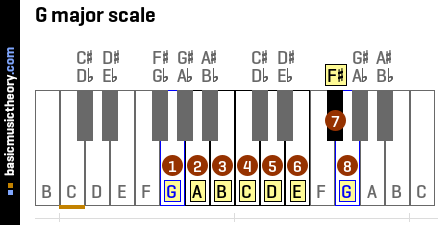
Middle C (midi note 60) is shown with an orange line under the 2nd note on the piano diagram.
These note names are shown below on the treble clef followed by the bass clef.


The stave diagrams above shows the scale notes without a key signature, with the sharp / flat adjustments inserted before each note on the staff.
For the key signature of this scale, showing these symbols grouped correctly next to the bass or treble clef symbol at the beginning, have a look at the G major key signature.
| Note no. | Degree name |
|---|---|
| 1 | G is the tonic of the G major scale |
| 2 | A is the supertonic of the G major scale |
| 3 | B is the mediant of the G major scale |
| 4 | C is the subdominant of the G major scale |
| 5 | D is the dominant of the G major scale |
| 6 | E is the submediant of the G major scale |
| 7 | F# is the leading tone of the G major scale |
| 8 | G is the octave of the G major scale |
| Bass Clef: | Midi | MP3 | Treble Clef: | Midi | MP3 |
2. G major scale descending
| No. | 1 | 2 | 3 | 4 | 5 | 6 | 7 |
|---|---|---|---|---|---|---|---|
| Note | F# | E | D | C | B | A | G |
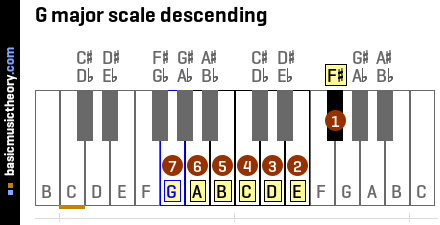
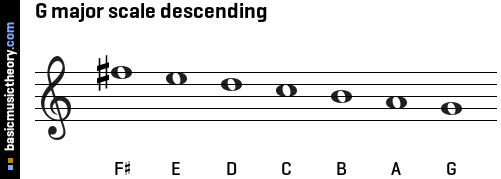
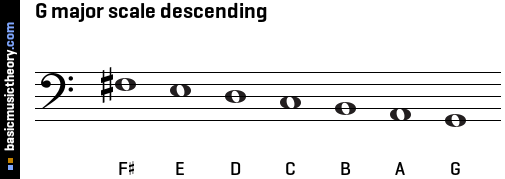
| Bass Clef: | Midi | MP3 | Treble Clef: | Midi | MP3 |
Lesson steps
1. Piano key note names
The white keys are named using the alphabetic letters A, B, C, D, E, F, and G, which is a pattern that repeats up the piano keyboard.
Every white or black key could have a flat(b) or sharp(#) accidental name, depending on how that note is used. In a later step, if sharp or flat notes are used, the exact accidental names will be chosen.
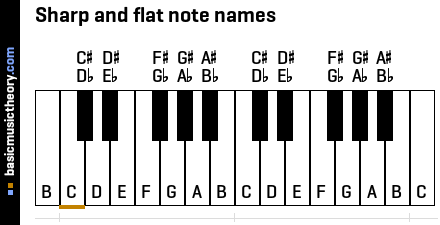
The audio files below play every note shown on the piano above, so middle C (marked with an orange line at the bottom) is the 2nd note heard.
| Bass Clef: | Midi | MP3 | Treble Clef: | Midi | MP3 |
2. G tonic note and one octave of notes
The numbered notes are those that might be used when building this note scale.
But since this is a scale in the key of G, it is certain that notes 1 and 13 will be used in the scale.
Note 1 is the tonic note - the starting note - G, and note 13 is the same note name but one octave higher.
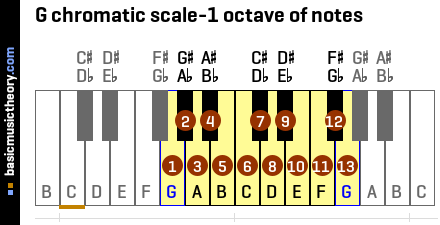
| No. | 1 | 2 | 3 | 4 | 5 | 6 | 7 | 8 | 9 | 10 | 11 | 12 | 13 |
|---|---|---|---|---|---|---|---|---|---|---|---|---|---|
| Note | G | G# / Ab | A | A# / Bb | B | C | C# / Db | D | D# / Eb | E | F | F# / Gb | G |
| Bass Clef: | Midi | MP3 | Treble Clef: | Midi | MP3 |
3. G major scale note interval positions
The major scale uses the W-W-H-W-W-W-H note counting rule to identify the scale note positions.
To count up a Whole tone, count up by two physical piano keys, either white or black.
To count up a Half-tone (semitone), count up from the last note up by one physical piano key, either white or black.
The tonic note (shown as *) is the starting point and is always the 1st note in the major scale.
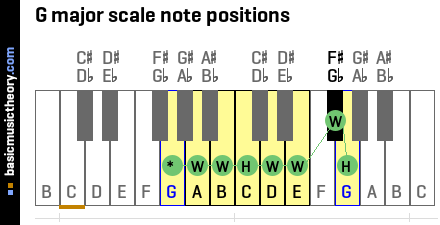
| No. | 1 | 2 | 3 | 4 | 5 | 6 | 7 | 8 |
|---|---|---|---|---|---|---|---|---|
| Note | G | A | B | C | D | E | F# / Gb | G |
| Bass Clef: | Midi | MP3 | Treble Clef: | Midi | MP3 |
4. G major scale notes
The 7 unique notes in a scale need to be named such that each letter from A to G is used once only, so each note name is either a natural white name(A.. G) , a sharp(eg. F#) or a flat(eg. Gb).
The rule ensures that every position of a staff is used once and once only - whether that position be a note in a space, or a note on a line.
This is needed to ensure that when it comes to writing the scale notes on a musical staff (eg. a bass or treble clef), there is no possibility of having 2 G-type notes, for example, with one of the notes needing an accidental next to it on the staff (a sharp, flat or natural symbol).
To apply this rule, firstly list the white key names starting from the tonic, which are shown the White column below.
Then list the 7 notes in the scale so far, shown in the next column.
For each of the 7 notes, look across and try to find the White note name in the Scale note name.
If the natural white note can be found in the scale note, the scale note is written in the Match? column.
The 8th note - the octave note, will have the same name as the first note, the tonic note.
| No. | White | Scale note | Match? |
|---|---|---|---|
| 1 | G | G | G |
| 2 | A | A | A |
| 3 | B | B | B |
| 4 | C | C | C |
| 5 | D | D | D |
| 6 | E | E | E |
| 7 | F | F# / Gb | F# |
| 8 | G | G | G |
For this major scale, all notes have a match, and so the Match? column shows the major scale note names.

5. G major scale descending
For major scales, the notes names when descending are just the reverse of the ascending names.
So assuming octave note 8 has been played in the step above, the notes now descend back to the tonic.

| No. | 1 | 2 | 3 | 4 | 5 | 6 | 7 |
|---|---|---|---|---|---|---|---|
| Note | F# | E | D | C | B | A | G |
| Bass Clef: | Midi | MP3 | Treble Clef: | Midi | MP3 |
6. G major scale degrees
Scale degree names 1,2,3,4,5,6, and 8 below are always the same for all major and minor scales (ie. 1st note is always tonic, 2nd is supertonic etc.) , but obviously the note names will be different for each scale / key combination.
In the major scale, the 7th note is called the leading note or leading tone because the sound of the 7th note feels like it wants to resolve and finish at the octave note, when all scale notes are played in sequence.
It does this because in this scale, the 7th note is only 1 semitone away from the 8th note - the octave note. The G harmonic minor scale and G melodic minor scale scales share the same property - they both have only one half-tone / semitone between the 7th and 8th notes.
In contrast, the G natural minor scale has a whole tone (two half-tones / semitones, two notes on the piano keyboard) between the 7th and 8th notes, and the 7th note does not lean towards the 8th note in the same way. In this case, the 7th note is called the subtonic.
| Note no. | Degree name |
|---|---|
| 1 | G is the tonic of the G major scale |
| 2 | A is the supertonic of the G major scale |
| 3 | B is the mediant of the G major scale |
| 4 | C is the subdominant of the G major scale |
| 5 | D is the dominant of the G major scale |
| 6 | E is the submediant of the G major scale |
| 7 | F# is the leading tone of the G major scale |
| 8 | G is the octave of the G major scale |
| Key | C | C# | Db | D | D# | Eb | E | E# | Fb | F | F# | Gb | [G] | G# | Ab | A | A# | Bb | B | B# | Cb | All On 1 page |
|---|